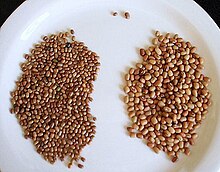Moth bean
| Vigna aconitifolia | |
|---|---|
 |
|
| Scientific classification | |
| Kingdom: | Plantae |
| (unranked): | Angiosperms |
| (unranked): | Eudicots |
| (unranked): | Rosids |
| Order: | Fabales |
| Family: | Fabaceae |
| Subfamily: | Faboideae |
| Tribe: | Phaseoleae |
| Genus: | Vigna |
| Species: | V. aconitifolia |
| Binomial name | |
|
Vigna aconitifolia (Jacq.) Marechal |
|
| Synonyms | |
|
Phaseolus aconitifolius Jacq. |
|
| Nutritional value per 100 g (3.5 oz) | |
|---|---|
| Energy | 1,436 kJ (343 kcal) |
|
61.5 g
|
|
|
1.6 g
|
|
|
22.9 g
|
|
| Vitamins | |
| Thiamine (B1) |
(52%)
0.6 mg |
| Riboflavin (B2) |
(8%)
0.1 mg |
| Niacin (B3) |
(19%)
2.8 mg |
| Pantothenic acid (B5) |
(10%)
0.5 mg |
| Vitamin B6 |
(31%)
0.4 mg |
| Folate (B9) |
(162%)
649 μg |
| Choline |
(0%)
0 mg |
| Vitamin C |
(8%)
7 mg |
| Vitamin E |
(0%)
0 mg |
| Vitamin K |
(0%)
0 μg |
| Minerals | |
| Calcium |
(15%)
150 mg |
| Iron |
(83%)
10.8 mg |
| Magnesium |
(107%)
381 mg |
| Manganese |
(86%)
1.8 mg |
| Phosphorus |
(70%)
489 mg |
| Potassium |
(25%)
1191 mg |
| Sodium |
(2%)
30 mg |
| Zinc |
(20%)
1.9 mg |
| Other constituents | |
| Water | 9.7 g |
| Ash | 4.3 g |
|
|
| Percentages are roughly approximated using US recommendations for adults. Source: USDA Nutrient Database |
|
Phaseolus aconitifolius Jacq.
Vigna aconitifolia is a drought-resistant legume, commonly grown in arid and semi-arid regions of India. It is commonly called mat bean, moth bean, matki, Turkish gram or dew bean. The pods, sprouts and protein rich seeds of this crop are commonly consumed in India. Moth bean can be grown on many soil types, and can also act as a pasture legume.
Moth bean is an herbaceous creeping annual which grows to approximately 40 cm high. Yellow flowers on its hairy and densely packed branches develop into yellow-brown pods, 2 to 3 inches in length The seeds of these pods contain approximately 22–24% protein.
Due to its drought resistant qualities, its ability to combat soil erosion and its high protein content, moth bean has been identified as possibly a more significant food source in the future. It has been suggested that its suitability as a grain legume in semi-arid Africa should be further investigated.
Belonging to the family Fabaceae (sub-family Papilionaceae), the moth bean is an herbaceous creeping annual that creates a low-lying soil cover when fully grown. Its stem can grow up to 40 cm in height, with its hairy and dense-packed branches reaching a span of up to 150 cm. Yellow flowers develop into a brown pod 2.5 to 5 cm in length, which holds 4 to 9 seeds inside. The rectangular seeds exist in a variety of colours including, yellow-brown, whitish green and mottled with black.
Moth bean is native to India and Pakistan, grown for food production and as a forage and cover crop. It is predominately grown in India, although it has been cultivated in the United States, Australia, Thailand and other parts of Asia. 1.5 million hectares of land is used in India for moth bean production, producing approximately 0.4 million t/ha of seeds [4] While its presence in Sudan, Somalia and other tropical countries of Africa has been noted, it has not been a crop of great importance to this region. The potential of increased production in this region in the future has been suggested.
Moth bean, a short-day crop, is one of the most drought resistant pulses in India. Grown at altitudes up to 1300m above sea level, it has a wide pH range (3.5–10) and can tolerate slight salinity. While dry sandy soil is most suitable for production, moth bean can tolerate a variety of soil types. The low lying soil cover the crop creates helps prevent soil erosion by preventing moisture loss.
Optimum production of moth bean occurs between 24–32 °C, but has been shown to tolerate up to 45 °C during the day. Growth is optimal at a constant temperature. The moth bean is one of the most drought resistant pulse in India, requiring little irrigation for production. While optimal annual rainfall for production is 500–750 mm, it is able to grow with 200–300 mm annually, and some yield has been noted at rainfall levels as low as 50–60 mm per year. Propagation of moth bean is done by seed, preferably on a prepared seedbed, at an optimal temperature of 25–27 °C. Fertilizer applications to moth bean are uncommon in India.
...
Wikipedia
